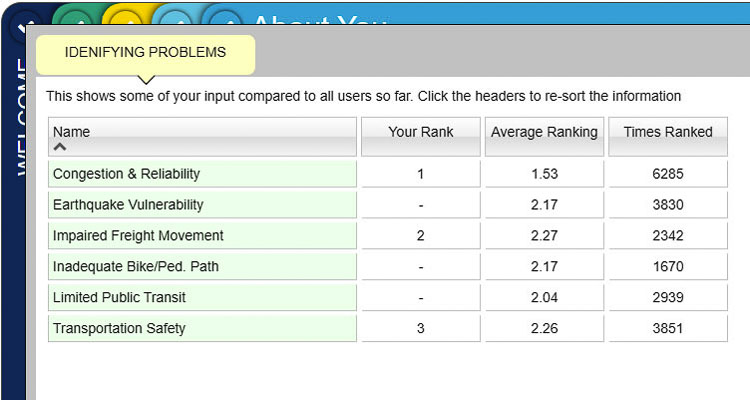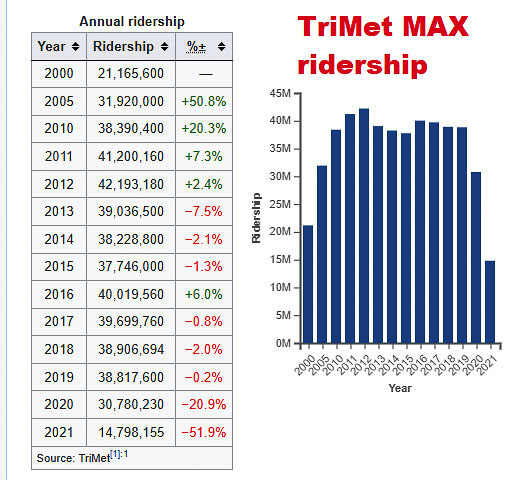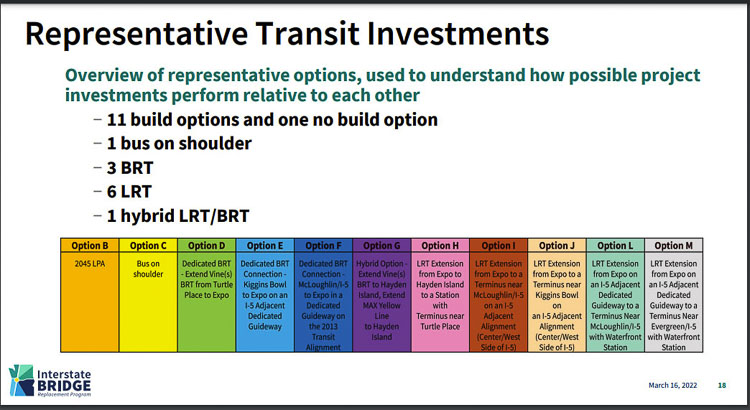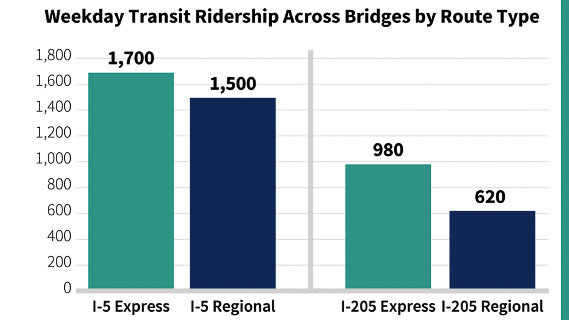Are 26,000 to 33,000 transit riders ‘strategic misrepresentation’ for IBR?
As the region awaits the arrival of President Biden to tout his $1.2 trillion transportation and infrastructure package, one key component expected to be announced will be the form of high capacity transit on the Interstate Bridge Replacement (IBR) project. There is a separate bucket of federal money for high capacity transit the project can compete for.
IBR Administrator Greg Johnson said recently that because the Washington legislature had committed local funds for the IBR ($1.1 billion of the $17 billion package) his IBR team would be able to apply for transit dollars this year instead of having to wait until next year.
In the failed Columbia River Crossing (CRC) effort, the inclusion of MAX light rail was extremely controversial. Clark County voters have rejected light rail every time they have been allowed to vote on the issue. In 2020, Portland metro area voters rejected a new light rail extension to Tigard/Tualatin.

During an April 7 meeting of the Executive Steering Group (ESG), Johnson said demand for transit on the I-5 corridor would increase 10-fold, to 26,000 to 33,000 boardings a day. His team had previously shared that 3,200 people used transit over the Columbia River daily. That was less than 2 percent of the people crossing the river.
“That is substantial demand,” he said.
Sen. Lynda Wilson (Republican, 17th District) had challenged Johnson for details two weeks earlier, noting transit was currently “under utilized.” Sen. Ann Rivers (Republican, 18th District) said: “When it comes to transit, there is maybe an inordinate optimism that exists. I hope that as we move on, we can get something that looks a little bit closer to reality.”
Yet the IBR team has yet to provide details on how those numbers were created and why citizens should trust the accuracy of them. Earlier this year, the Southwest Washington Regional Transportation Council (RTC) could not provide numbers to back up the “substantial demand” claim. “In regards to your request, RTC can’t fulfill it, because we don’t possess the entire results,” Director Matt Ransom said.
Total MAX light rail ridership peaked a decade ago in 2012 at 35 million originating rides, declining 12 percent to just below 31 million in 2019 before the pandemic. The addition of two new light rail lines failed to stimulate ridership. TriMet officials appear to be on track to be short of their optimistic projections by over 50,000 passengers for just two of their light rail lines.
Busiest bus lane in the nation?
The Exclusive Bus Lane (XBL) connects the New Jersey Turnpike to the Lincoln Tunnel that serves midtown Manhattan. A summary from the Port Authority of NY-NJ website is as follows:
Since 1970, the XBL has served as a critical element of the interstate transportation corridor linking New Jersey and Midtown Manhattan. This 2.5-mile managed-use lane on NJ Route 495 is by far the busiest and most productive highway lane in the nation, moving over 1,850 buses and 70,000 passengers each weekday morning.
It is a contraflow lane that operates from 6 a.m.-10 a.m., using the middle tube of the 3-tube Lincoln Tunnel.
“Try to imagine MAX moving 70,000 passengers during a four-hour period,” said John Charles of the Cascade Policy Institute. “It’s not possible, because light rail is low-capacity transit.”
“I have to say, if you’re a transit geek, traveling down the 2.5 mile XBL is an awesome experience,” he said. “The throughput is phenomenal. But it’s only during rush hour. At other times of the day, it would not make sense to reserve an entire lane for bus transit. So that’s my point about the IBRP project; there is no rationale for rail transit, and even bus transit would only move a lot of people for an hour or two.”
Engineering malpractice
Randall O’Toole has been examining transit for decades and is known as the “Anti Planner.” He talks about “strategic misrepresentation” as a form of lying on light rail and these mega projects. He notes they over project transit ridership and under estimate costs in a recent column, Lie Rail Supporters Keep On Lying.
The Antiplanner has previously written that light rail should be called lie rail because everything its advocates say about it is a lie. The latest proof comes from Capital Metro, Austin’s transit agency, which now admits that light-rail projects voters approved in 2020 are going to cost at least 78 percent more than originally projected.
Many observers believe this has become standard practice for consultants and bureaucrats on government transportation contracts. They create multiple “bad” options or choices, so the one thing they are pushing looks good and rises to the top. The fact that the IBR team and its (WSP USA) consultants appear to now be pushing a bridge too low, the need for high capacity transit, and no improvement in travel time for drivers raises the question as to whether that is going on in this process.
O’Toole noted “the original projection, of course, was one of many lies told about the project. Almost every light-rail project ever built has cost far more than the original projections, overruns so systematic that Oxford researcher Bent Flyvbjerg says they are “best explained by strategic misrepresentation, that is, lying.” Other lies included overestimated ridership numbers and the claim that light rail is “high-capacity transit.”

A recent article by Charles Marohn in the publication Strong Towns, shows how the game is played. He calls it “engineering malpractice.” He also labels seeking public input: “engagement theater.”
The engineers put together options, most frequently three of them. “The first is the “do nothing” approach, the hated status quo that most everyone agrees is intolerable,” he said. “The second is some lavish, over-the-top approach that seems ridiculous. And the third approach is the baby bear; not too big and not too small, in contrast with the others it will seem to be just right.”
It is all part of a sales job, including the anchoring effect of juxtapositioning the professional’s preferred alternative between two unappealing options, according to Marohn.
“Engineers and project planners use the public comment process to go through engagement theater and simulate that they actually care about the feedback they are receiving, earnestly considering it instead of what they are really doing: working through the process to overcome opposition so they can move on to the building phase of the project,” he said.
All this is highly reminiscent of the IBR process. They have created three separate committees. An Equity Advisory Group (EAG), the Community Advisory Group (CAG), and the ESG. They have over 70 members all providing “input” in their monthly meetings.
Yet, not focused on the fact that the people, the taxpayers’ top priority, is reducing traffic congestion and saving time. Several community surveys indicate 78 percent of Washington residents and 70 percent of regional residents list traffic congestion and lost time as their top priority for the project.
More transit options is not at the top of anyone’s list. Seismic vulnerability and safety are.
Yet the IBR is proposing six light rail transit options, three bus rapid transit (BRT) options, one hybrid option, and one bus on shoulder option. The indications and “hint” is that light rail will be the preferred choice the IBR staff makes tomorrow.

C-TRAN
Recent analysis on transit costs showed C-TRAN’s operating costs for its BRT system are 34 percent cheaper than the operating costs (per boarding rider) for the MAX light rail. TriMet’s MAX costs are $8.24 versus C-TRAN’s $5.44 BRT cost per boarding passenger.
C-TRAN CEO Shawn Donaghy was recently asked how his firm would respond to that level of increased demand. What would it look like?
Does C-TRAN have the capacity to carry that many passengers across the river? – C-TRAN has the ability to expand its network to meet the needs of growing ridership. The 26-33,000 riders are a function of a “max” utilization in a 2045 scenario. It could require there to be changes to fleet types (such as double decker buses) and operational upgrades to travel space, crossings and the Downtown Transit Mall in Portland. It would also require connectivity to additional modes so that the network is not overburdened.
What would that level of service on C-TRAN BRT buses look like? – In a growing ridership scenario, it would include the addition of more frequent headways, that would utilize the current bus-on-shoulder network moving into a dedicated space (if BRT is the selected mode). It would also include the expansion of the current Express Bus service to create utilization of all service networks.
The ridership generation would be a function of several things – mode selected, transit terminals along the corridor, alignment (I-5 “hugging” or on City Streets), number of lanes (and auxiliary lanes) as well as other critical factors that the project will need to take into account. As an example, the CRC 2045 Option B Alignment assumed 26,600 riders per day – however, much has changed both in terms of infrastructure investment and development on the Southwest Washington side that makes this alignment much more difficult to execute in this iteration. Final ridership numbers will be identified as a throughput of project decisions made.
Broken promises
The Cascade Policy Institute has documented multiple broken promises by TriMet, when it comes to the MAX light rail service. Every time they have failed to meet those promised levels of service or passengers being carried.
TriMet officials promised the FTA in their Full-Funding Grant Agreement (FFGA) that peak-hour trains would arrive every 10 minutes and off-peak trains every 15 minutes. The promised service according to the EIS was supposed to reach eight trains during peak hours in 2020, or one train every 7.5 minutes.
The EIS forecasted ridership in the corridor would dramatically increase with the building of the Yellow Line. By 2020, the line’s ridership was expected to have 18,100 average weekday riders. It was 5,290, with a shortfall of 12,810 riders.
At no point since the Yellow Line opened has ridership met projected levels. In April 2019 ridership only reached 13,270, over 26 percent less than projected. This number did not meet 2020 projected levels. From March 2016 to March 2019 ridership levels decreased by 3.6 percent. The pandemic lockdown caused transit ridership to decline roughly 70 percent.
Lower than promised ridership isn’t unique to the Yellow Line. Every TriMet light rail forecast has been wrong, and always wrong on the high side according to the Cascade Policy Institute.

Yesterday, Congresswoman Jaime Herrera Beutler pushed back against light rail being pushed for the project. In a letter to Johnson, she emphasized that voters had rejected light rail multiple times.
Light rail has been rejected – repeatedly — by voters in Southwest Washington by overwhelming margins. Whatever IBR officials see as the merits of light rail, they must be able to demonstrate that the transit component of the project is supported by the citizens who will use and pay for it. There is no such evidence that supersedes multiple votes of the people, which are the most fundamental demonstrations of community will.
Former Metro councilor Robert Liberty also called out the deception earlier this year. He had a front row seat to the entire CRC process.
“The new name, the Interstate Bridge Replacement Project is a sign of how deceptive the whole effort is because it is based directly on the Columbia River Crossing, both in a legal and technical sense,” he said. “But that has been confirmed by the project staff who are a set of consultants and staff from the two departments of transportation, they’ve described it as tweaking the old project, a revival of the old project.”
“People who are participating in this process are not even clear who makes this decision, who has final authority,” he said. “I think this is also part of the strategy to keep things vague and confused; decision points unclear.”
With the release of information tomorrow on numerous aspects of the IBR recommendation, citizens should scrutinize the details, especially those regarding transit. Is it inordinate optimism? Is it “strategic misrepresentation?” Have citizens been participating in “engagement theater?” Is the transportation component of the project another “lie rail” as O’Toole labels it?
With TriMet being short over 50,000 “promised” boardings for the Yellow and Green MAX lines, will the IBR be adding another 20,000 or 30,000 to the broken promises?




